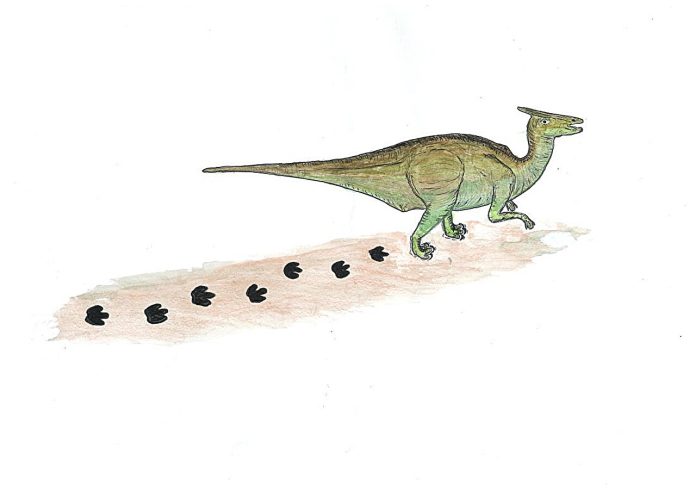
A team of researchers from Okayama University of Science (OUS) in Japan and the Institute of Paleontology, Mongolian Academy of Sciences has discovered some of the largest dinosaur footprints ever found.
The footprints, measuring 92 cm wide, are believed to have belonged to a massive Saurolophus, a type of hadrosaur, or “duck-billed” dinosaur.
Scientists estimate that this dinosaur could have been over 15 meters long, making it larger than the famous Tyrannosaurus and Tarbosaurus.
This exciting discovery suggests that one of the biggest bipedal (two-legged) dinosaurs ever known once roamed Mongolia.
Scientists now hope to find its skeletal remains, which could provide even more clues about this prehistoric giant.
A long trackway and more footprints
Along with the giant footprint, the research team also found a trackway—a series of 13 fossilized footprints, each 85 cm wide, stretching 24 meters across the Gobi Desert.
The presence of so many footprints in one area suggests that these dinosaurs may have moved in groups, possibly traveling together in herds.
This site was first identified in a 2018 survey, but the recent June 2024 expedition, led by Dr. Shinobu Ishigaki, the Director of the OUS Museum of Dinosaur Research, uncovered even more footprints. On August 2, 2024, Dr. Ishigaki announced the findings in a press conference, stating:
“By studying these trackways, we can learn about the posture, walking style, speed, and even group behavior of these dinosaurs—details that cannot be understood from bones alone.”
A record-breaking hadrosaur?
Until now, the largest hadrosaur skeleton belonged to Shantungosaurus, a dinosaur found in China. However, the newly discovered footprints in Mongolia suggest that similarly massive dinosaurs lived in this region as well.
Dr. Ishigaki and his team now hope to find a full skeleton of the giant Saurolophus responsible for these tracks.
If they succeed, it could be a major breakthrough in dinosaur research, revealing new information about the size, movement, and behavior of these prehistoric creatures.
This discovery highlights Mongolia’s rich fossil history and raises exciting possibilities for future paleontology expeditions.
Scientists will continue searching the region in hopes of uncovering more clues about one of the largest bipedal dinosaurs to ever walk the Earth.



